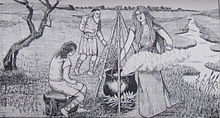Ceridwen
Ceridwen ( Welsh [ ke'ridwen ], also Carridwen or Kerridwen ) is a figure of medieval sagas in the Celtic mythology of Wales .
mythology
She is said to have been the wife of the sea spirit Tegid Foel and mother of the beautiful Creirwy and Morfran ap Tegid as well as the ugly Afaggdu. To compensate for its ugliness, she brewed a potion in a magical cauldron that should make her son the wisest of all beings. Gwion Bach, who was supposed to guard the kettle and keep stirring the potion, happened to get the first three drops of the hot brew on his thumb when the potion was finished. He put his finger in his mouth so that the spell worked on him instead of Afaggdus. In anger, Ceridwen tried to kill Gwion and a long chase ensued. The boy changed shape to a hare; she turned into a black hunting dog. They took on new animal and vegetable forms until Gwion turned into a grain and hid in the grain. Ceridwen turned into a hen and picked it up.
Soon after, Gwion was reborn to Ceridwen and later became the greatest poet and bard of the Britons. This story is recorded in the Hanes Taliesin ("The Tale of Taliesin"), a Welsh tale from the 16th century. Ceridwen put her young son out in a boat on the sea, where he was found by the Elphins and carried home. Here he was given the name Taliesin ("shining forehead") because he was very wise.
Interpretation and attributes
It is often thought that Ceridwen can be traced back to an ancient Celtic deity . Many equate her with the Irish Brigid . Ceridwen is a guardian of the cauldron of the Otherworld and the mistress of the grain. She is mostly depicted as an old woman with dark prophetic qualities. As a symbol of fertility, it is usually accompanied by a mother sow. Her two children, Creirwy and Afaggdu, were opposite in appearance and character, so her daughter was known as the most beautiful girl ever born. She was warm-hearted and radiated light. Her son, on the other hand, was considered the ugliest boy who ever lived. He was cold and dismissive and was characterized by a dark disposition. From this depiction of an old woman with a seething cauldron, the image of the witch in the folk tale was probably created.
See also
- List of Celtic gods and legendary figures
- Myths and legends from Wales and Britain
- Celtic cauldron cult
- Celtic women
literature
- Hannes Taliesin. In: Bernhard Maier : Lexicon of Celtic Religion and Culture (= Kröner's pocket edition . Volume 466). Kröner, Stuttgart 1994, ISBN 3-520-46601-5 .
Individual evidence
- ↑ a b Felix Korn: Etymological-symbolic-mythological real dictionary for manual use by biblical scholars, archaeologists and visual artists, containing the animal, plant, color and number symbolism: with consideration for the symbolic ... volume 1 . Cast, Stuttgart 1843, OCLC 833121377 , p. 337-339 ( online ).
- ^ A b c Wilhelm Vollmer, W. Binder, Johannes Minckwitz: Dr. Vollmer's dictionary of the mythology of all peoples . Hoffmann, Stuttgart 1874, OCLC 10203756 ( Ceridwen - Britt. Mythology ).
- ↑ a b The Cauldron of the Ceridwen. ( Memento of the original from March 4, 2016 in the Internet Archive ) Info: The archive link was inserted automatically and has not yet been checked. Please check the original and archive link according to the instructions and then remove this notice. In: Diana L. Paxson: The sacred island. […]: The Lady of Camelot / with a post by Helmut W. Pesch . 1st edition. Bastei Lübbe, Bergisch Gladbach 2004, ISBN 3-404-20484-0 , p. 259–278 (Afterword: The Holy Grail and the Treasures of Britain ).
